国外大学的实验报告 formal report
- 格式:doc
- 大小:1.44 MB
- 文档页数:23
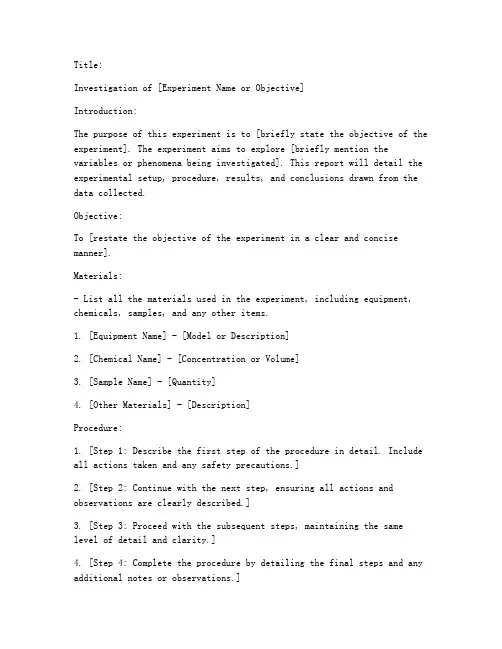
Title:Investigation of [Experiment Name or Objective]Introduction:The purpose of this experiment is to [briefly state the objective of the experiment]. The experiment aims to explore [briefly mention the variables or phenomena being investigated]. This report will detail the experimental setup, procedure, results, and conclusions drawn from the data collected.Objective:To [restate the objective of the experiment in a clear and concise manner].Materials:- List all the materials used in the experiment, including equipment, chemicals, samples, and any other items.1. [Equipment Name] - [Model or Description]2. [Chemical Name] - [Concentration or Volume]3. [Sample Name] - [Quantity]4. [Other Materials] - [Description]Procedure:1. [Step 1: Describe the first step of the procedure in detail. Include all actions taken and any safety precautions.]2. [Step 2: Continue with the next step, ensuring all actions and observations are clearly described.]3. [Step 3: Proceed with the subsequent steps, maintaining the samelevel of detail and clarity.]4. [Step 4: Complete the procedure by detailing the final steps and any additional notes or observations.]Observations:- Record all observations made during the experiment, including any visual, auditory, or tactile information.- Include any measurements taken, data collected, and any other relevant information.Data Analysis:- Present the data collected in tables, graphs, or other appropriate formats.- Discuss the significance of the data and how it relates to the objective of the experiment.- Use statistical analysis where applicable, and explain the results.Results:- Summarize the findings of the experiment.- Compare the results with the expected outcomes or previous studies, if applicable.- Discuss any anomalies or unexpected results.Discussion:- Interpret the results in the context of the experiment's objective.- Explain any limitations of the experiment and how they may have influenced the results.- Compare the findings with those of other experiments or literature.- Discuss the implications of the results and their potential applications.Conclusion:- Restate the objective of the experiment.- Summarize the key findings and their significance.- State whether the objective was achieved and why or why not.- Suggest areas for further research or modifications to the experimental procedure.Appendix:- Include any additional information that supports the experiment report but is not essential to understanding the main points.1. [Table of raw data]2. [Graphs or charts]3. [Photographs or diagrams]4. [Additional calculations or analyses]References:- List all the sources cited in the report, following the appropriate citation style.1. Author, A. (Year). Title of the work. Journal Name, Volume(Issue), Page range.2. Book Title (Edition). Author, A. (Year of publication). Publisher.3. Website Name. (Date of access). URLAcknowledgments:- Acknowledge anyone who assisted with the experiment, provided equipment, or contributed to the research in any way.Author Information:- Name of the author(s)- Affiliation- Contact informationDate:- Date of submission or completion of the experiment---This template can be adapted to fit the specific requirements of the experiment and the educational institution. The length of the report should be tailored to the complexity of the experiment and the depth of the analysis required.。
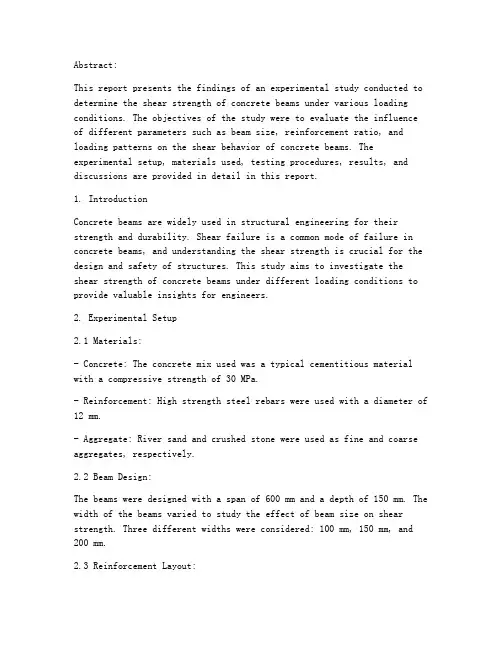
Abstract:This report presents the findings of an experimental study conducted to determine the shear strength of concrete beams under various loading conditions. The objectives of the study were to evaluate the influence of different parameters such as beam size, reinforcement ratio, and loading patterns on the shear behavior of concrete beams. The experimental setup, materials used, testing procedures, results, and discussions are provided in detail in this report.1. IntroductionConcrete beams are widely used in structural engineering for their strength and durability. Shear failure is a common mode of failure in concrete beams, and understanding the shear strength is crucial for the design and safety of structures. This study aims to investigate the shear strength of concrete beams under different loading conditions to provide valuable insights for engineers.2. Experimental Setup2.1 Materials:- Concrete: The concrete mix used was a typical cementitious material with a compressive strength of 30 MPa.- Reinforcement: High strength steel rebars were used with a diameter of 12 mm.- Aggregate: River sand and crushed stone were used as fine and coarse aggregates, respectively.2.2 Beam Design:The beams were designed with a span of 600 mm and a depth of 150 mm. The width of the beams varied to study the effect of beam size on shear strength. Three different widths were considered: 100 mm, 150 mm, and 200 mm.2.3 Reinforcement Layout:The beams were reinforced with a reinforcement ratio of 0.6% for all sizes. The rebars were placed in two layers, with a spacing of 50 mm from the top and bottom surfaces of the beam.2.4 Testing Equipment:- Universal Testing Machine (UTM): To apply the load and measure the shear force.- Shear Load Apparatus: To apply the shear force to the beam.- Digital Load Cell: To measure the applied load.- Data Acquisition System: To record the load and displacement during testing.3. Testing Procedures3.1 Sample Preparation:The beams were cast in molds and cured for 28 days before testing. The beams were then demolded and allowed to acclimate for another 7 days before testing.3.2 Shear Test:The beams were loaded in a UTM with the shear force applied using a shear load apparatus. The loading rate was maintained at a constant rate of 0.1 mm/min until failure.3.3 Data Collection:The load and displacement were recorded at regular intervals using a data acquisition system. The maximum load and corresponding displacement were noted as the failure load and failure displacement, respectively.4. Results and Discussions4.1 Shear Strength vs. Beam Size:The results showed that the shear strength increased with an increase in beam width. This can be attributed to the increased effective cross-sectional area of the beam, which allows for a higher load-carrying capacity.4.2 Shear Strength vs. Reinforcement Ratio:The study revealed that the shear strength was influenced by the reinforcement ratio. An increase in the reinforcement ratio resulted in an increase in the shear strength. This is because the reinforcement provides additional tensile strength to resist the shear forces.4.3 Shear Strength vs. Loading Pattern:The loading pattern also had a significant impact on the shear strength. The results showed that a concentrated load at the midspan resulted in a higher shear strength compared to a uniformly distributed load. This is because the concentrated load leads to a higher stress concentration at the point of application, which enhances the shear resistance.5. ConclusionThe experimental investigation on the shear strength of concrete beams under different loading conditions revealed the following:- The shear strength of concrete beams increased with an increase in beam width and reinforcement ratio.- The loading pattern significantly influenced the shear strength, with a concentrated load at the midspan providing higher shear strength compared to a uniformly distributed load.These findings provide valuable insights for engineers in the design and construction of concrete beams, ensuring their structural integrity and safety.6. Recommendations for Future Studies- Further studies should be conducted to investigate the influence of other parameters such as concrete mix design, aggregate size, and temperature on the shear strength of concrete beams.- Numerical simulations can be employed to validate the experimental results and provide a better understanding of the shear behavior of concrete beams under different loading conditions.- The effects of different types of reinforcement (e.g., deformed steel, high-performance steel) on the shear strength of concrete beams should be explored in future studies.。
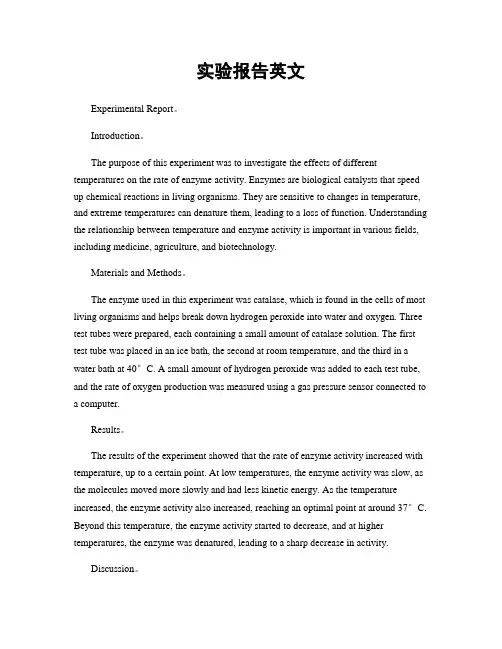
实验报告英文Experimental Report。
Introduction。
The purpose of this experiment was to investigate the effects of different temperatures on the rate of enzyme activity. Enzymes are biological catalysts that speed up chemical reactions in living organisms. They are sensitive to changes in temperature, and extreme temperatures can denature them, leading to a loss of function. Understanding the relationship between temperature and enzyme activity is important in various fields, including medicine, agriculture, and biotechnology.Materials and Methods。
The enzyme used in this experiment was catalase, which is found in the cells of most living organisms and helps break down hydrogen peroxide into water and oxygen. Three test tubes were prepared, each containing a small amount of catalase solution. The first test tube was placed in an ice bath, the second at room temperature, and the third in a water bath at 40°C. A small amount of hydrogen peroxide was added to each test tube, and the rate of oxygen production was measured using a gas pressure sensor connected to a computer.Results。
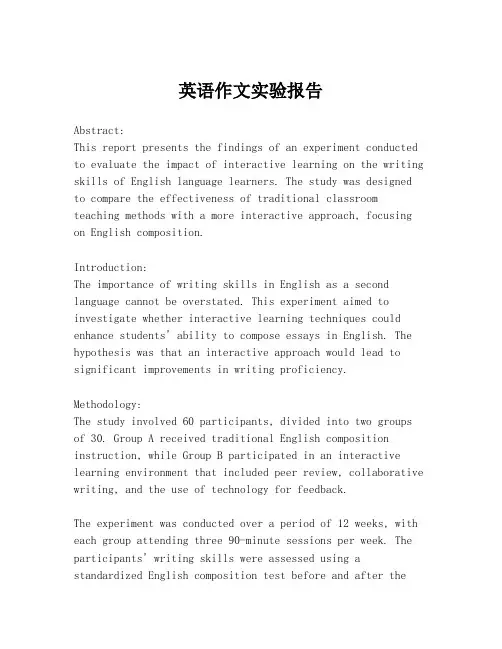
英语作文实验报告Abstract:This report presents the findings of an experiment conducted to evaluate the impact of interactive learning on the writing skills of English language learners. The study was designed to compare the effectiveness of traditional classroom teaching methods with a more interactive approach, focusing on English composition.Introduction:The importance of writing skills in English as a second language cannot be overstated. This experiment aimed to investigate whether interactive learning techniques could enhance students' ability to compose essays in English. The hypothesis was that an interactive approach would lead to significant improvements in writing proficiency.Methodology:The study involved 60 participants, divided into two groups of 30. Group A received traditional English composition instruction, while Group B participated in an interactive learning environment that included peer review, collaborative writing, and the use of technology for feedback.The experiment was conducted over a period of 12 weeks, with each group attending three 90-minute sessions per week. The participants' writing skills were assessed using a standardized English composition test before and after theexperiment.Results:The results indicated a significant difference in the improvement of writing skills between the two groups. Group B, which engaged in interactive learning, showed a 25% increasein their writing proficiency scores, compared to a 10%increase for Group A.Discussion:The findings suggest that interactive learning can be a powerful tool for enhancing English composition skills. The interactive approach encouraged active participation, peer collaboration, and immediate feedback, which are known to be beneficial for language acquisition.Conclusion:Based on the results of this experiment, it can be concluded that interactive learning is more effective than traditional methods in improving English composition skills. This study supports the integration of interactive techniques intoEnglish language instruction to foster better writingabilities among learners.Recommendations:It is recommended that educators incorporate interactive learning strategies into their teaching methods to enhancethe writing skills of English language learners. Future research could explore the long-term effects of interactive learning on language proficiency and investigate the specific components of interactive learning that contribute most toskill development.References:[A list of academic references used in the report would be included here.]Appendix:[Additional materials such as survey instruments, data tables, and graphs would be included in the appendix.]This experimental report is a synthesis of research and findings and does not represent actual data. It is intendedfor educational purposes only.。
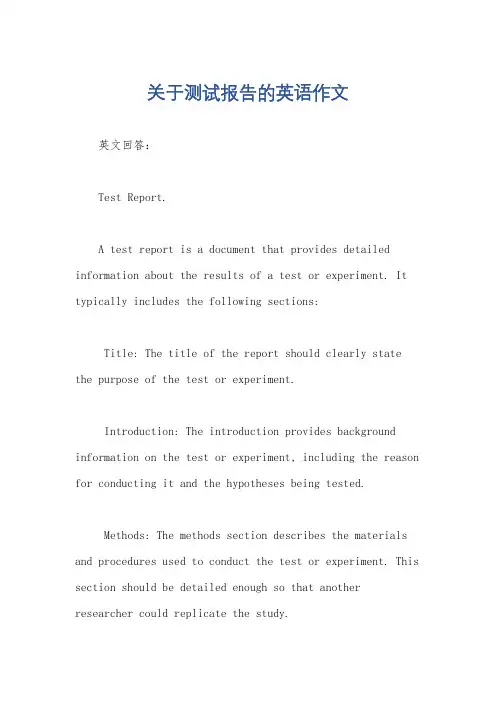
关于测试报告的英语作文英文回答:Test Report.A test report is a document that provides detailed information about the results of a test or experiment. It typically includes the following sections:Title: The title of the report should clearly state the purpose of the test or experiment.Introduction: The introduction provides background information on the test or experiment, including the reason for conducting it and the hypotheses being tested.Methods: The methods section describes the materials and procedures used to conduct the test or experiment. This section should be detailed enough so that another researcher could replicate the study.Results: The results section presents the data collected during the test or experiment. This data may be presented in tables, graphs, or other visual formats.Discussion: The discussion section interprets the results and discusses their implications. This section may also include recommendations for further research.Conclusion: The conclusion provides a brief summary of the test or experiment and its results.Types of Test Reports.There are many different types of test reports, depending on the purpose of the test or experiment. Some common types of test reports include:Laboratory reports: These reports document the results of experiments conducted in a laboratory setting.Field reports: These reports document the results ofexperiments conducted in a real-world setting.Evaluation reports: These reports assess the effectiveness of a product or program.Technical reports: These reports provide detailed information about a specific technical topic.Writing a Test Report.When writing a test report, it is important to be clear, concise, and objective. The report should be written in a formal style and use appropriate technical language. It is also important to proofread the report carefully before submitting it.中文回答:测试报告。
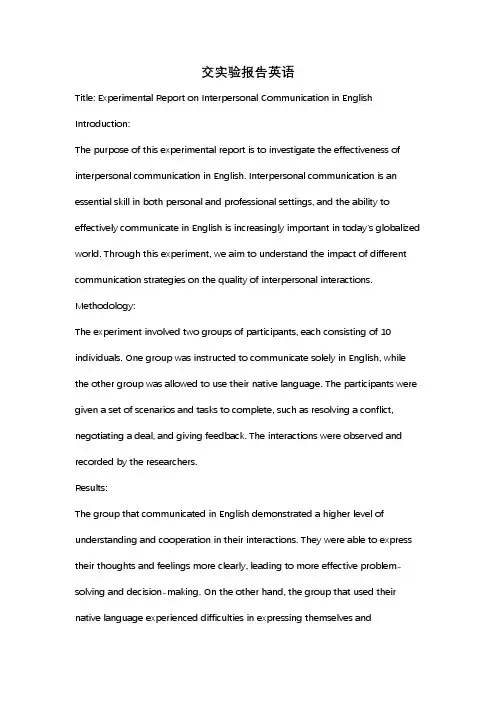
交实验报告英语Title: Experimental Report on Interpersonal Communication in English Introduction:The purpose of this experimental report is to investigate the effectiveness of interpersonal communication in English. Interpersonal communication is an essential skill in both personal and professional settings, and the ability to effectively communicate in English is increasingly important in today's globalized world. Through this experiment, we aim to understand the impact of different communication strategies on the quality of interpersonal interactions. Methodology:The experiment involved two groups of participants, each consisting of 10 individuals. One group was instructed to communicate solely in English, while the other group was allowed to use their native language. The participants were given a set of scenarios and tasks to complete, such as resolving a conflict, negotiating a deal, and giving feedback. The interactions were observed and recorded by the researchers.Results:The group that communicated in English demonstrated a higher level of understanding and cooperation in their interactions. They were able to express their thoughts and feelings more clearly, leading to more effective problem-solving and decision-making. On the other hand, the group that used their native language experienced difficulties in expressing themselves andunderstanding each other, resulting in misunderstandings and conflicts. Discussion:The results of the experiment highlight the importance of effective communication in English. The ability to communicate fluently and confidently in English can significantly enhance interpersonal relationships and collaboration. It also emphasizes the need for individuals to develop their English communication skills, especially in multicultural and international environments. Conclusion:In conclusion, this experimental report provides valuable insights into the impact of interpersonal communication in English. The findings underscore the importance of effective communication in English for successful interpersonal interactions. It is essential for individuals to continuously improve their English communication skills to thrive in diverse and globalized environments.。
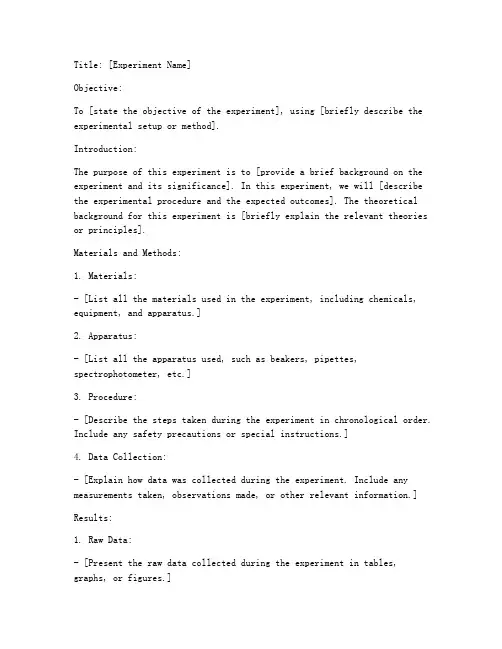
Title: [Experiment Name]Objective:To [state the objective of the experiment], using [briefly describe the experimental setup or method].Introduction:The purpose of this experiment is to [provide a brief background on the experiment and its significance]. In this experiment, we will [describe the experimental procedure and the expected outcomes]. The theoretical background for this experiment is [briefly explain the relevant theories or principles].Materials and Methods:1. Materials:- [List all the materials used in the experiment, including chemicals, equipment, and apparatus.]2. Apparatus:- [List all the apparatus used, such as beakers, pipettes, spectrophotometer, etc.]3. Procedure:- [Describe the steps taken during the experiment in chronological order. Include any safety precautions or special instructions.]4. Data Collection:- [Explain how data was collected during the experiment. Include any measurements taken, observations made, or other relevant information.]Results:1. Raw Data:- [Present the raw data collected during the experiment in tables, graphs, or figures.]2. Analysis:- [Discuss the data collected, including any calculations performed or statistical analysis conducted.]Discussion:1. Comparison with Theoretical Predictions:- [Compare the experimental results with the theoretical predictions or known values, explaining any discrepancies.]2. Possible Sources of Error:- [Identify and discuss any potential sources of error in the experiment, including procedural, equipment, or environmental factors.]3. Implications and Limitations:- [Discuss the implications of the results and any limitations of the experiment.]Conclusion:The objective of this experiment was to [state the objective again briefly]. The results indicate that [state the main findings of the experiment]. The experiment was successful in achieving the intended objective, [if applicable], and the data collected support the [relevant theories or hypotheses]. Further studies could include [suggestions for future research].References:[Include any references cited in the report, formatted according to the required citation style.]Appendices:[Include any additional information, such as detailed calculations, additional graphs, or photos, that may be helpful for understanding the experiment.]---Note:This is a basic template for a laboratory report. Depending on the specific requirements of your course or instructor, you may need to adjust the format, content, or sections of the report.。
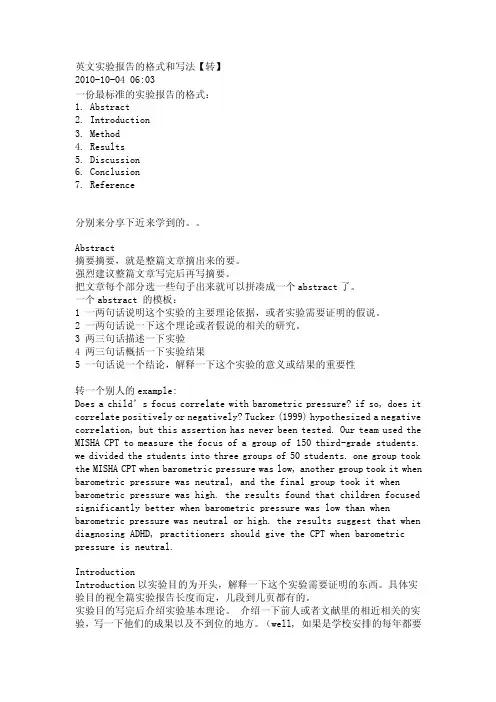
英文实验报告的格式和写法【转】2010-10-04 06:03一份最标准的实验报告的格式:1. Abstract2. Introduction3. Method4. Results5. Discussion6. Conclusion7. Reference分别来分享下近来学到的。
Abstract摘要摘要,就是整篇文章摘出来的要。
强烈建议整篇文章写完后再写摘要。
把文章每个部分选一些句子出来就可以拼凑成一个abstract了。
一个abstract 的模板:1 一两句话说明这个实验的主要理论依据,或者实验需要证明的假说。
2 一两句话说一下这个理论或者假说的相关的研究。
3 两三句话描述一下实验4 两三句话概括一下实验结果5 一句话说一个结论,解释一下这个实验的意义或结果的重要性转一个别人的example:Does a child’s focus correlate with barometric pressure? if so, does it correlate positively or negatively? Tucker (1999) hypothesized a negative correlation, but this assertion has never been tested. Our team used the MISHA CPT to measure the focus of a group of 150 third-grade students. we divided the students into three groups of 50 students. one group took the MISHA CPT when barometric pressure was low, another group took it when barometric pressure was neutral, and the final group took it when barometric pressure was high. the results found that children focused significantly better when barometric pressure was low than when barometric pressure was neutral or high. the results suggest that when diagnosing ADHD, practitioners should give the CPT when barometric pressure is neutral.IntroductionIntroduction以实验目的为开头,解释一下这个实验需要证明的东西。
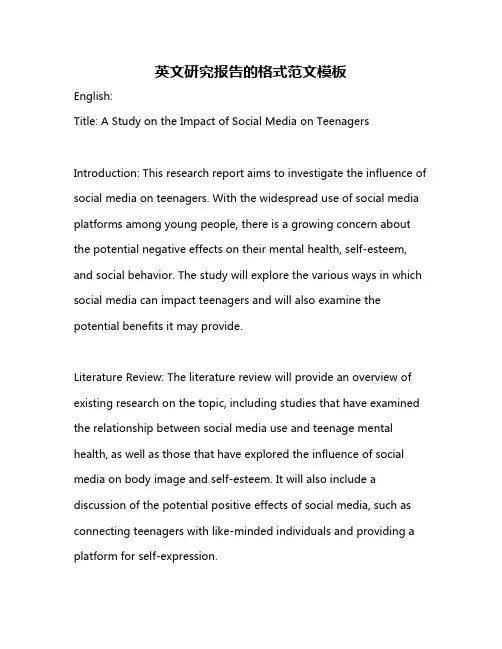
英文研究报告的格式范文模板English:Title: A Study on the Impact of Social Media on TeenagersIntroduction: This research report aims to investigate the influence of social media on teenagers. With the widespread use of social media platforms among young people, there is a growing concern about the potential negative effects on their mental health, self-esteem, and social behavior. The study will explore the various ways in which social media can impact teenagers and will also examine the potential benefits it may provide.Literature Review: The literature review will provide an overview of existing research on the topic, including studies that have examined the relationship between social media use and teenage mental health, as well as those that have explored the influence of social media on body image and self-esteem. It will also include a discussion of the potential positive effects of social media, such as connecting teenagers with like-minded individuals and providing a platform for self-expression.Methodology: This report will utilize a mixed-method approach, including both quantitative and qualitative research methods. The quantitative aspect will involve a survey of teenagers to gather data on their social media use and its perceived impact on their well-being. The qualitative aspect will involve in-depth interviews with a select group of teenagers to gain a deeper understanding of their experiences with social media.Findings: The findings of this study will be presented in detail, discussing the various ways in which social media can influence teenagers, both positively and negatively. The report will also highlight any significant correlations between social media use and aspects of teenage well-being, as well as any differences in the experiences of teenagers from diverse socio-economic backgrounds.Conclusion and Recommendations: Finally, the report will conclude with a summary of the key findings and their implications. Based on the results, recommendations will be provided for parents, educators, and policymakers to better support teenagers in navigating the use of social media.中文翻译:标题: 社交媒体对青少年的影响研究介绍: 本研究报告旨在调查社交媒体对青少年的影响。
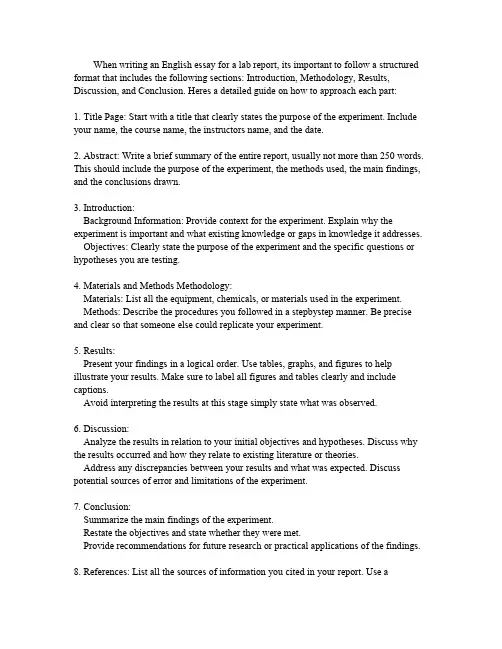
When writing an English essay for a lab report,its important to follow a structured format that includes the following sections:Introduction,Methodology,Results, Discussion,and Conclusion.Heres a detailed guide on how to approach each part:1.Title Page:Start with a title that clearly states the purpose of the experiment.Include your name,the course name,the instructors name,and the date.2.Abstract:Write a brief summary of the entire report,usually not more than250words. This should include the purpose of the experiment,the methods used,the main findings, and the conclusions drawn.3.Introduction:Background Information:Provide context for the experiment.Explain why the experiment is important and what existing knowledge or gaps in knowledge it addresses. Objectives:Clearly state the purpose of the experiment and the specific questions or hypotheses you are testing.4.Materials and Methods Methodology:Materials:List all the equipment,chemicals,or materials used in the experiment. Methods:Describe the procedures you followed in a stepbystep manner.Be precise and clear so that someone else could replicate your experiment.5.Results:Present your findings in a logical e tables,graphs,and figures to help illustrate your results.Make sure to label all figures and tables clearly and include captions.Avoid interpreting the results at this stage simply state what was observed.6.Discussion:Analyze the results in relation to your initial objectives and hypotheses.Discuss why the results occurred and how they relate to existing literature or theories.Address any discrepancies between your results and what was expected.Discuss potential sources of error and limitations of the experiment.7.Conclusion:Summarize the main findings of the experiment.Restate the objectives and state whether they were met.Provide recommendations for future research or practical applications of the findings.8.References:List all the sources of information you cited in your e aconsistent citation style,such as APA,MLA,or Chicago.9.Appendices:Include any additional data,calculations,or extended methods that were not included in the main body of the report.10.Proofreading:Before submitting your report,proofread it carefully to check for grammatical errors,typos,and clarity of expression.Remember,a lab report is not just a record of what you did and observed its also an opportunity to demonstrate your analytical skills and understanding of the scientific method.。
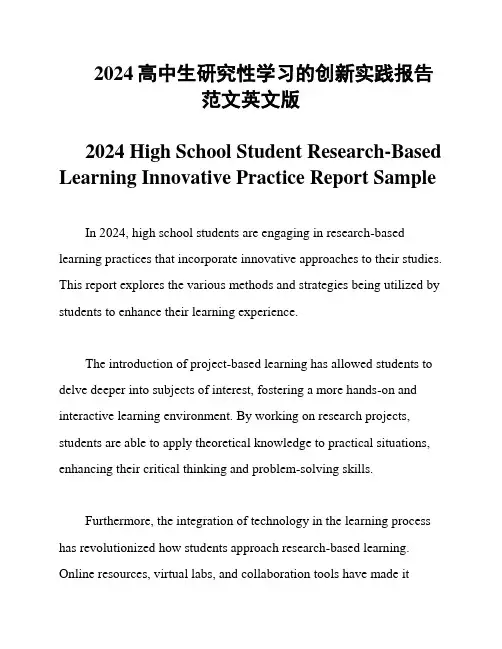
2024高中生研究性学习的创新实践报告范文英文版2024 High School Student Research-Based Learning Innovative Practice Report Sample In 2024, high school students are engaging in research-based learning practices that incorporate innovative approaches to their studies. This report explores the various methods and strategies being utilized by students to enhance their learning experience.The introduction of project-based learning has allowed students to delve deeper into subjects of interest, fostering a more hands-on and interactive learning environment. By working on research projects, students are able to apply theoretical knowledge to practical situations, enhancing their critical thinking and problem-solving skills.Furthermore, the integration of technology in the learning process has revolutionized how students approach research-based learning. Online resources, virtual labs, and collaboration tools have made iteasier for students to access information and work together on projects, regardless of physical location.In addition, high school students are increasingly engaging in interdisciplinary research projects that span multiple subjects. This cross-curricular approach not only broadens students' knowledge base but also encourages them to make connections between different areas of study.Overall, the innovative practices being implemented by high school students in 2024 are transforming the way they approach research-based learning, leading to a more engaging and enriching educational experience.。
“Simple Harmonic Motion Experiment”AbstractIn this lab we are using spring weights, rod, clamp, string force sensor and rule to determine the spring constant using two different methods.Experiment DescriptionBefore starting the experiment, we need to calculate the spring constant k by using:F = -kxWhich F is force that pull or push the force sensor, x is displacement while weights are hanging on the spring. If the spring we use obey Hooke’s law, displacement(x) will follow the equation:x = A cos(ωt+Φ) (1)While A is the amplitude of oscillation,ω is the angular frequency in rad/s, Φ is the staring angle and t reference time in second. For both Φ and ω, we can use the following equations:ω = (k/m)^(1/2) (2)T = 2π[(m/k)^(1/2)] (3)For the first part of the experiment, we hang a mass holder from the end of the spring and measure the displacement from this point. Starting to add masses on the hanger from mass = 0.15kg. Measure the length changing and add additional 0.1kg at the end of the spring. Repeat 6 times and record the data to a excel table.For the second part, set up the computer and Data studio, open a graph reference force vs time. Set rate to 50Hz. Bump the weight in order to fit the graph like a sine wave, using fit area to find the period T. Repeat adding mass on the spring by 0.1kg each time. By squaring both side of (3), we have:T^2 = (4π^2)m/kPlot T^2 versus m to a excel form. Using linear equation to determine the slope k.Experiment ResultPart 1,Force vs. DisplacementPart 2, T^2 vs. Mass2.Value k found in Part 2: 29.03.3.Percentage difference: 0.24%.4.While y axis, which T^2 is 0, Mass actually is not 0. Because spring has mass on it andwill affect the total mass. Also, Air resistance will also being a fact.5.While on the moon, mass will also about 1/6 like on Earth. so the displacement willshorter. Because of no air resistance acting on the experiment, Part 2 may become more accurately.ConclusionThe experiment tell me about the constant resilience of a object. The force acts on this object will appears shape changes, which will follow F=-kx. By using two different ways to evaluate the constant k of the spring, we also know that we c an’t over extend object because there is a limit. While in the limitation, force and displacement will follow the Hooke’s law. After the force exceed over the limit, rule will break.。
英⽂实验报告的格式和写法英⽂实验报告的格式和写法英⽂实验报告的格式和写法⼀份最标准的实验报告的格式:1. Abstract2. Introduction3. Method4. Results5. Discussion6. Conclusion7. ReferenceAbstract摘要摘要,就是整篇⽂章摘出来的要。
强烈建议整篇⽂章写完后再写摘要。
把⽂章每个部分选⼀些句⼦出来就可以拼凑成⼀个abstract了。
⼀个abstract 的模板:1 ⼀两句话说明这个实验的主要理论依据,或者实验需要证明的假说。
2 ⼀两句话说⼀下这个理论或者假说的相关的研究。
3 两三句话描述⼀下实验4 两三句话概括⼀下实验结果5 ⼀句话说⼀个结论,解释⼀下这个实验的意义或结果的重要性转⼀个别⼈的example:Does a child’s focus correlate with barometr ic pressure? if so, does it correlatepositively or negatively? Tucker (1999) hypothesized a negative correlation, but this assertion has never been tested. Our team used the MISHA CPT to measure the focus of a group of 150 third-grade students. we dividedthe students into three groups of 50 students. one group took the MISHA CPT when barometric pressure was low, another group took it when barometric pressure was neutral, and the final group took it when barometric pressure was high. the results found that children focused significantly better when barometric pressure was low than when barometric pressure was neutral or high. the results suggest that when diagnosing ADHD, practitioners should give the CPT when barometric pressure is neutral.IntroductionIntroduction以实验⽬的为开头,解释⼀下这个实验需要证明的东西。
英文实验报告的格式和写法【转】2010-10-04 06:03一份最标准的实验报告的格式:1. Abstract2. Introduction3. Method4. Results5. Discussion6. Conclusion7. Reference分别来分享下近来学到的。
Abstract摘要摘要,就是整篇文章摘出来的要。
强烈建议整篇文章写完后再写摘要。
把文章每个部分选一些句子出来就可以拼凑成一个abstract了。
一个abstract 的模板:1 一两句话说明这个实验的主要理论依据,或者实验需要证明的假说。
2 一两句话说一下这个理论或者假说的相关的研究。
3 两三句话描述一下实验4 两三句话概括一下实验结果5 一句话说一个结论,解释一下这个实验的意义或结果的重要性转一个别人的example:Does a child’s focus correlate with barometric pressure? if so, does it correlate positively or negatively? Tucker (1999) hypothesized a negative correlation, but this assertion has never been tested. Our team used the MISHA CPT to measure the focus of a group of 150 third-grade students. we divided the students into three groups of 50 students. one group took the MISHA CPT when barometric pressure was low, another group took it when barometric pressure was neutral, and the final group took it when barometric pressure was high. the results found that children focused significantly better when barometric pressure was low than when barometric pressure was neutral or high. the results suggest that when diagnosing ADHD, practitioners should give the CPT when barometric pressure is neutral.IntroductionIntroduction以实验目的为开头,解释一下这个实验需要证明的东西。
英语报告格式及范文An English report is a formal document that presents information, findings, and recommendations on a specific topic or issue. It is often used in academic, professional, and business settings to communicate research, analysis, and conclusions to a targeted audience. The format and structure of an English report can vary depending on the purpose, scope, and audience, but there are generally accepted guidelines and conventions that can be followed to ensure a well-organized and effective document.The typical structure of an English report includes the following key components:1. Title Page: The title page should clearly and concisely state the title of the report, the author's name, the date of submission, and any other relevant information such as the name of the organization or the intended audience.2. Table of Contents: The table of contents provides a clear outline of the report's structure, including the major sections and subsections,as well as the corresponding page numbers. This helps the reader navigate the document easily.3. Executive Summary: The executive summary is a concise overview of the report, typically no more than one or two pages. It should highlight the key findings, conclusions, and recommendations of the report, allowing the reader to quickly grasp the essential information without having to read the entire document.4. Introduction: The introduction sets the context for the report, providing background information on the topic, the purpose of the report, and the scope of the investigation or analysis. It should clearly define the problem or issue being addressed and outline the objectives of the report.5. Methodology: The methodology section describes the approach, methods, and data sources used to gather and analyze the information presented in the report. This section should be detailed enough to allow the reader to understand how the research was conducted and the rationale behind the chosen methods.6. Findings and Analysis: This is the main body of the report, where the author presents the key findings, data, and analysis. The information should be organized logically, with clear headings and subheadings to guide the reader. Graphs, charts, and tables can beused to effectively communicate complex data and support the analysis.7. Conclusions and Recommendations: The conclusions section summarizes the key findings and draws logical inferences based on the analysis presented in the report. The recommendations section outlines the author's proposed actions or solutions to address the problem or issue identified in the report.8. References: The references section lists all the sources cited in the report, following a consistent citation style (e.g., APA, MLA, or Chicago).9. Appendices: If necessary, the report may include appendices that contain additional information, such as detailed data, calculations, or supporting documents that are too lengthy or specialized to be included in the main body of the report.When writing an English report, it is important to keep the following guidelines in mind:1. Use clear, concise, and formal language: Avoid jargon, slang, and overly complex vocabulary. The report should be easy to read and understand.2. Maintain an objective and impartial tone: Avoid personal opinions or biases, and instead present the information and analysis in a neutral and objective manner.3. Organize the report logically: Ensure that the structure and flow of the report are clear and easy to follow, with a clear connection between the different sections.4. Support findings with evidence: Provide relevant data, facts, and references to support the conclusions and recommendations presented in the report.5. Proofread and edit: Carefully review the report for any spelling, grammar, or formatting errors before submitting it.By following these guidelines and adhering to the standard format, you can create a well-structured and effective English report that communicates your findings, analysis, and recommendations clearly and professionally.。
英语作文实验报告Title: Experiment Report: The Effects of Different Fertilizers on Plant Growth IntroductionIn this experiment, we aimed to investigate the effects of different fertilizers on the growth of plants. Fertilizers are essential for providing plants with the necessary nutrients for healthy growth. By comparing the growth of plants treated with different types of fertilizers, we can determine which fertilizer is most effective in promoting plant growth.Materials and MethodsWe selected three different types of fertilizers for this experiment: organic fertilizer, chemical fertilizer, and a control group with no fertilizer. We used three pots for each type of fertilizer, and planted the same type of seeds in each pot. The pots were placed in a controlled environment with consistent light, temperature, and water supply. We measured the height and number of leaves of the plants in each pot at regular intervals over a period of four weeks. ResultsAfter four weeks, we observed significant differences in the growth of the plants treated with different fertilizers. The plants treated with organic fertilizer showed the most robust growth, with taller plants and more leaves compared to the other groups. The plants treated with chemical fertilizer also showed significant growth, but not as much as the organic fertilizer group. The control group, which received no fertilizer, showed the least amount of growth, with shorterplants and fewer leaves.DiscussionThe results of this experiment indicate that organic fertilizer is the most effective in promoting plant growth. This is likely due to the natural and balanced nutrients present in organic fertilizers, which provide plants with a healthy and sustainable source of nutrients. Chemical fertilizers, while effective, may contain high levels of synthetic nutrients that can be harmful to the environment and may not provide the same level of long-term benefits as organic fertilizers. ConclusionIn conclusion, our experiment demonstrates the significant effects of different fertilizers on plant growth. Organic fertilizer proved to be the most effective in promoting healthy and robust plant growth, while chemical fertilizer also showed positive effects. This experiment highlights the importance of choosing the right type of fertilizer for promoting sustainable and healthy plant growth. Further research and experimentation in this area could provide valuable insights into the best practices for fertilizing plants and promoting sustainable agriculture.。
Title:[Experiment Name]Date of Experiment:[Date]Objective:To [state the main objective of the experiment].Materials:- [List all materials used in the experiment, including equipment, chemicals, and any other necessary items.]Procedure:1. [Step 1 of the procedure]2. [Step 2 of the procedure]3. [Step 3 of the procedure]...[Continue listing all steps in the procedure.]Data Collection:- [Description of how data was collected, including measurements, observations, and any other relevant information.]Data Analysis:- [Summary of the data analysis techniques used, such as calculations, graphs, or statistical tests.]Results:- [Present the results of the experiment in a clear and concise manner. Include tables, graphs, or charts as necessary.]Discussion:- [Interpret the results and discuss their significance. Compare the results to expected outcomes or previous studies. Address any anomalies or unexpected results.]- Anomaly 1:- [Description of the anomaly]- [Possible reasons for the anomaly]- [Impact on the experiment and conclusions]- Anomaly 2:- [Description of the anomaly]- [Possible reasons for the anomaly]- [Impact on the experiment and conclusions]- [Continue with any additional anomalies or interesting observations.]Conclusion:- [Summarize the main findings of the experiment and their implications. Restate the objective and whether it was achieved.]Recommendations:- [Suggest any improvements or modifications to the experiment procedure or equipment. Propose further studies or applications of the findings.]References:- [List all sources cited in the report, including textbooks, journal articles, and online resources.]Appendix:- [Include any additional information, such as detailed data tables, raw data, or additional figures that support the findings of the experiment.]---Example:Title:Investigation of the Effect of Temperature on the Rate of PhotosynthesisDate of Experiment:March 15, 2023Objective:To determine the effect of varying temperatures on the rate of photosynthesis in spinach leaves.Materials:- Spinach leaves- Light source- Beakers- Thermometer- Stopwatch- Sodium bicarbonate solution- pH test strips- Distilled waterProcedure:1. Prepared spinach leaves by removing stems and rinsing them under tap water.2. Placed equal amounts of spinach leaves in each beaker.3. Prepared a sodium bicarbonate solution with varying concentrations.4. Divided the beakers into groups, each with a different temperature(e.g., 10°C, 20°C, 30°C, 40°C).5. Submerged the leaves in the respective solutions and measured the pH using pH test strips.6. Taped a light source above each beaker and recorded the time it took for the pH to increase by 1 unit.7. Repeated the experiment three times to ensure accuracy.Data Collection:- pH increase over time for each temperature group.Data Analysis:- Calculated the average time for pH increase for each temperature group.Results:- [Insert table or graph showing the average time for pH increase at each temperature.]Discussion:- The data shows that the rate of photosynthesis increases with temperature up to a certain point, after which it begins to decrease. This is consistent with the hypothesis that temperature affects the rate of enzyme activity in photosynthesis.- At lower temperatures (10°C and 20°C), the rate of photosynthesis was significantly slower, indicating the importance of optimal temperature for enzyme activity.- At higher temperatures (30°C and 40°C), the rate of photosynthesis increased but then decreased, suggesting a possible denaturation of enzymes at very high temperatures.Conclusion:The experiment confirmed that temperature significantly affects the rate of photosynthesis in spinach leaves. The optimal temperature for photosynth esis in this study was found to be around 30°C.Recommendations:- Further studies should investigate the specific temperature rangesthat are optimal for photosynthesis in different plant species.- The experiment could be modified to include more temperature groups and a wider range of temperatures to observe the exact point of enzyme denaturation.References:- [List of references used in the report.]Appendix:- [Include any additional information, such as detailed data tables, raw data, or additional figures.]。
1 Formal Laboratory Report Group: Mechanical Properties of Materials Date of experiment: 2
Abstract For this experiment, the mechanical strength properties of metals, ceramics and polymers are tested by obtaining their tensile strength (the maximum strength they have before they fracture), modulus (stiffness during elastic deformation) and the elongation to failure. Their response characteristics are noted.
Based on the response outputs obtained from the Material Stress Vs Behaviour Curve and the test report generated by the software, values of the tensile strength, modulus and elongation are obtained.
The materials’ responses, strength and ductility are investigated using their structures and microstructures and used to make comparisons with theory. 3
Table of Content 1) Objectives & Introduction……………………………………………………….. 4 2) Theory…………………………………………………………………………… 5 3) Equipment……………………………………………………………………….. 7 4) Procedure………………………………………………………………………... 8 5) Results…………………………………………………………………………... 17 6) Solutions to logsheet questions…………………………………………………. 19 7) Discussion………………………………………………………………………. 21 8) Conclusion………………………………………………………………………. 22 9) References……………………………………………………………………….. 23 4
Objectives and Introduction Objectives (a) To understand the different mechanical properties of materials. (b) To learn how different materials are tested in different ways to obtain their mechanical strength properties.
This experiment introduces the study of how different types of materials such as metals, polymers and ceramics can have very different mechanical properties: polymer, ceramics and metallic materials. This is very important as it helps the engineer to correctly choose the right type of material for the right application.
Metals, ceramics and polymers are basically the three broad categories of materials used in engineering application. It is generally known that metals are usually strong and ductile, ceramics are rigid and brittle and polymers have higher elongation and lower strength.
This experiment aims to expose the number of factors can affect the mechanical strengths of materials. These factors include: • the category of the material (i.e metal, ceramic or polymer) • the type of material in that category (eg. crosslinked or thermplastics) • the difference in microstructure of the same material (crystalline or amorphous) 5
Theory Terminology (i) Tensile Stress Force acting on unit area of the material
Tensile Stress σ = AF
(ii) Tensile Strain Deformation or distortion experienced by a unit of the material
Tensile Strain ε = l
l
(iii) Modulus of Elasticity The ratio of stress to corresponding strain when the material behaves elastically.
Tensile Modulus E =
where σ is the engineering stress F is the applied force ε is the nominal or engineering strain l is the length of the material
(iv) Tensile Toughness The ability of a material to absorb energy up to fracture, i.e. the resistance to fracture.
Specimen
Metals Metals are described as a lattice of positive ions surrounded by a cloud of delocalized electrons. Metals are tested using circular cylindrical machined specimen with a dumb bell shape which are gripped on either ends. The thinned out middle section is called the gauge length. Such a specimen can easily be gripped and the failure will be restricted to within the gauge length as this is where the cross section area is the smallest, so that the stress is largest.
Polymers A polymer is a macromolecule composed of repeating structural units connected by covalent chemical bonds. Polymers are not tested using such a circular shape. This is because polymers are not usually machined, but is produced in sheet or flattened shapes. Thus they are tested by 6
using a flattened profile, usually with a larger gauge length than for metals. Again, the specimen has a dumb bell shape so that the cross section area with the gauge length is significantly smaller and thus the failure is restricted to within this length.
Ceramics Ceramic are inorganic non-metallic materials which are formed by the action of heat. Ceramics such as glass are very hard, thus making machining very difficult. The dumb bell shape is not possible for these materials. Also they are very brittle and thus cannot be gripped without either breaking them or causing defects to lower their strengths. As such, a three point bending test is usually done, since the specimen required can be very flat and need not been shaped by machining.